Facilitated Communication for Autism: A Critical Analysis
VerifiedAdded on 2022/11/26
|7
|1564
|153
AI Summary
This essay critically analyzes the use of facilitated communication as a means of communication for children with autism. It discusses the effectiveness of the treatment program and the research related to facilitated communication. The essay also examines rebuttal research and provides a response based on the evidence. The conclusion suggests that facilitated communication may not be a suitable treatment for children with autism.
Contribute Materials
Your contribution can guide someone’s learning journey. Share your
documents today.
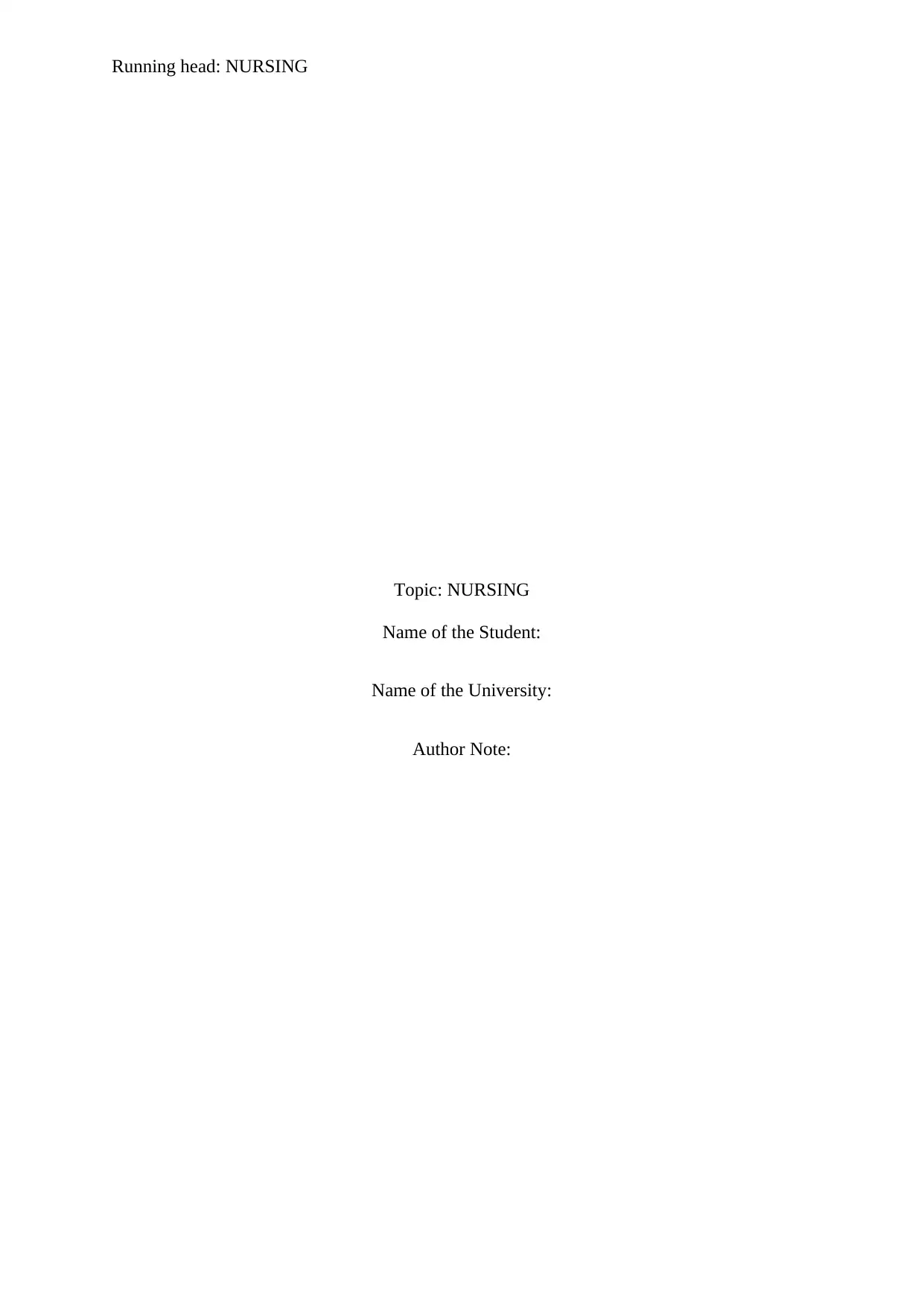
Running head: NURSING
Topic: NURSING
Name of the Student:
Name of the University:
Author Note:
Topic: NURSING
Name of the Student:
Name of the University:
Author Note:
Secure Best Marks with AI Grader
Need help grading? Try our AI Grader for instant feedback on your assignments.
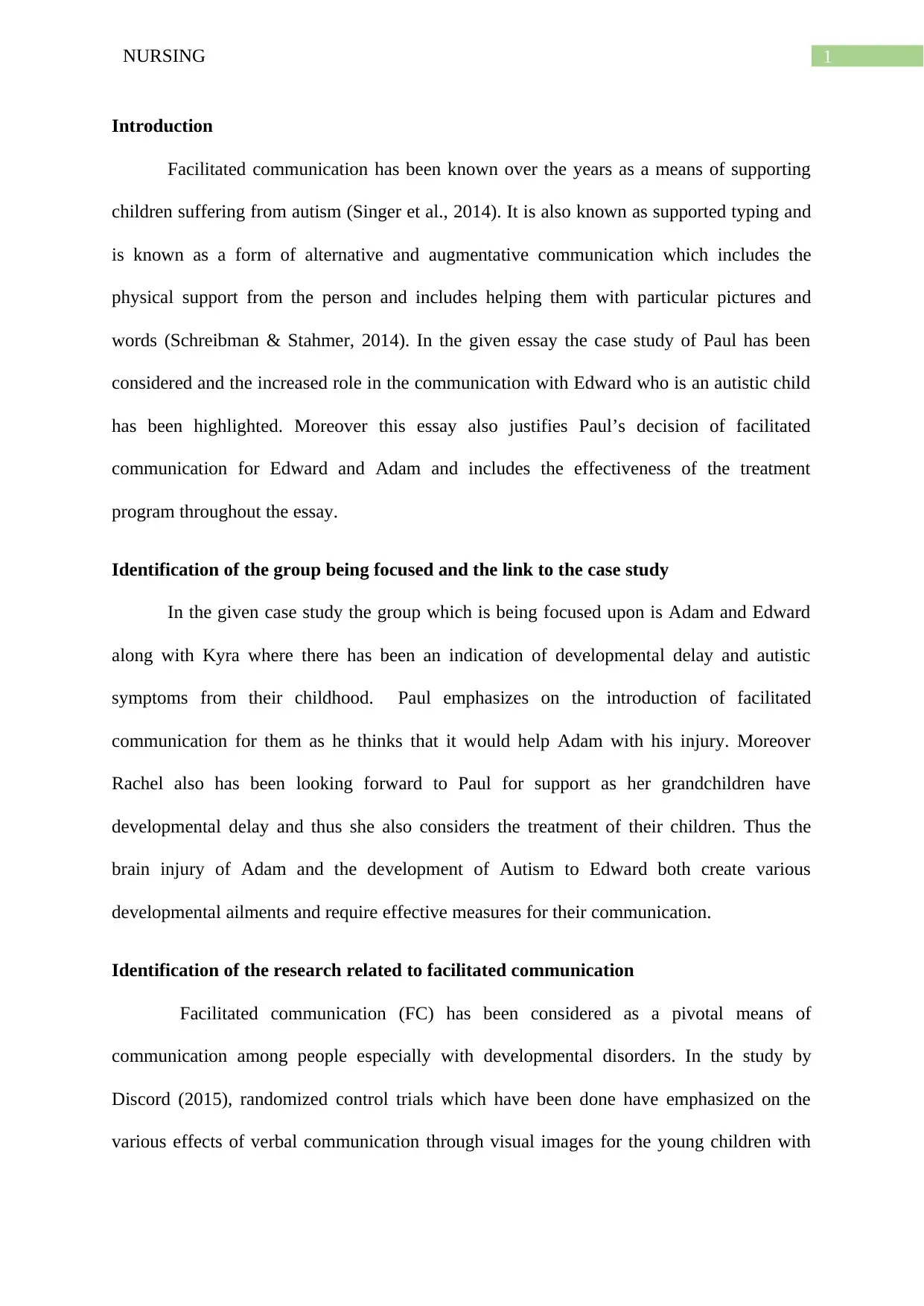
1NURSING
Introduction
Facilitated communication has been known over the years as a means of supporting
children suffering from autism (Singer et al., 2014). It is also known as supported typing and
is known as a form of alternative and augmentative communication which includes the
physical support from the person and includes helping them with particular pictures and
words (Schreibman & Stahmer, 2014). In the given essay the case study of Paul has been
considered and the increased role in the communication with Edward who is an autistic child
has been highlighted. Moreover this essay also justifies Paul’s decision of facilitated
communication for Edward and Adam and includes the effectiveness of the treatment
program throughout the essay.
Identification of the group being focused and the link to the case study
In the given case study the group which is being focused upon is Adam and Edward
along with Kyra where there has been an indication of developmental delay and autistic
symptoms from their childhood. Paul emphasizes on the introduction of facilitated
communication for them as he thinks that it would help Adam with his injury. Moreover
Rachel also has been looking forward to Paul for support as her grandchildren have
developmental delay and thus she also considers the treatment of their children. Thus the
brain injury of Adam and the development of Autism to Edward both create various
developmental ailments and require effective measures for their communication.
Identification of the research related to facilitated communication
Facilitated communication (FC) has been considered as a pivotal means of
communication among people especially with developmental disorders. In the study by
Discord (2015), randomized control trials which have been done have emphasized on the
various effects of verbal communication through visual images for the young children with
Introduction
Facilitated communication has been known over the years as a means of supporting
children suffering from autism (Singer et al., 2014). It is also known as supported typing and
is known as a form of alternative and augmentative communication which includes the
physical support from the person and includes helping them with particular pictures and
words (Schreibman & Stahmer, 2014). In the given essay the case study of Paul has been
considered and the increased role in the communication with Edward who is an autistic child
has been highlighted. Moreover this essay also justifies Paul’s decision of facilitated
communication for Edward and Adam and includes the effectiveness of the treatment
program throughout the essay.
Identification of the group being focused and the link to the case study
In the given case study the group which is being focused upon is Adam and Edward
along with Kyra where there has been an indication of developmental delay and autistic
symptoms from their childhood. Paul emphasizes on the introduction of facilitated
communication for them as he thinks that it would help Adam with his injury. Moreover
Rachel also has been looking forward to Paul for support as her grandchildren have
developmental delay and thus she also considers the treatment of their children. Thus the
brain injury of Adam and the development of Autism to Edward both create various
developmental ailments and require effective measures for their communication.
Identification of the research related to facilitated communication
Facilitated communication (FC) has been considered as a pivotal means of
communication among people especially with developmental disorders. In the study by
Discord (2015), randomized control trials which have been done have emphasized on the
various effects of verbal communication through visual images for the young children with
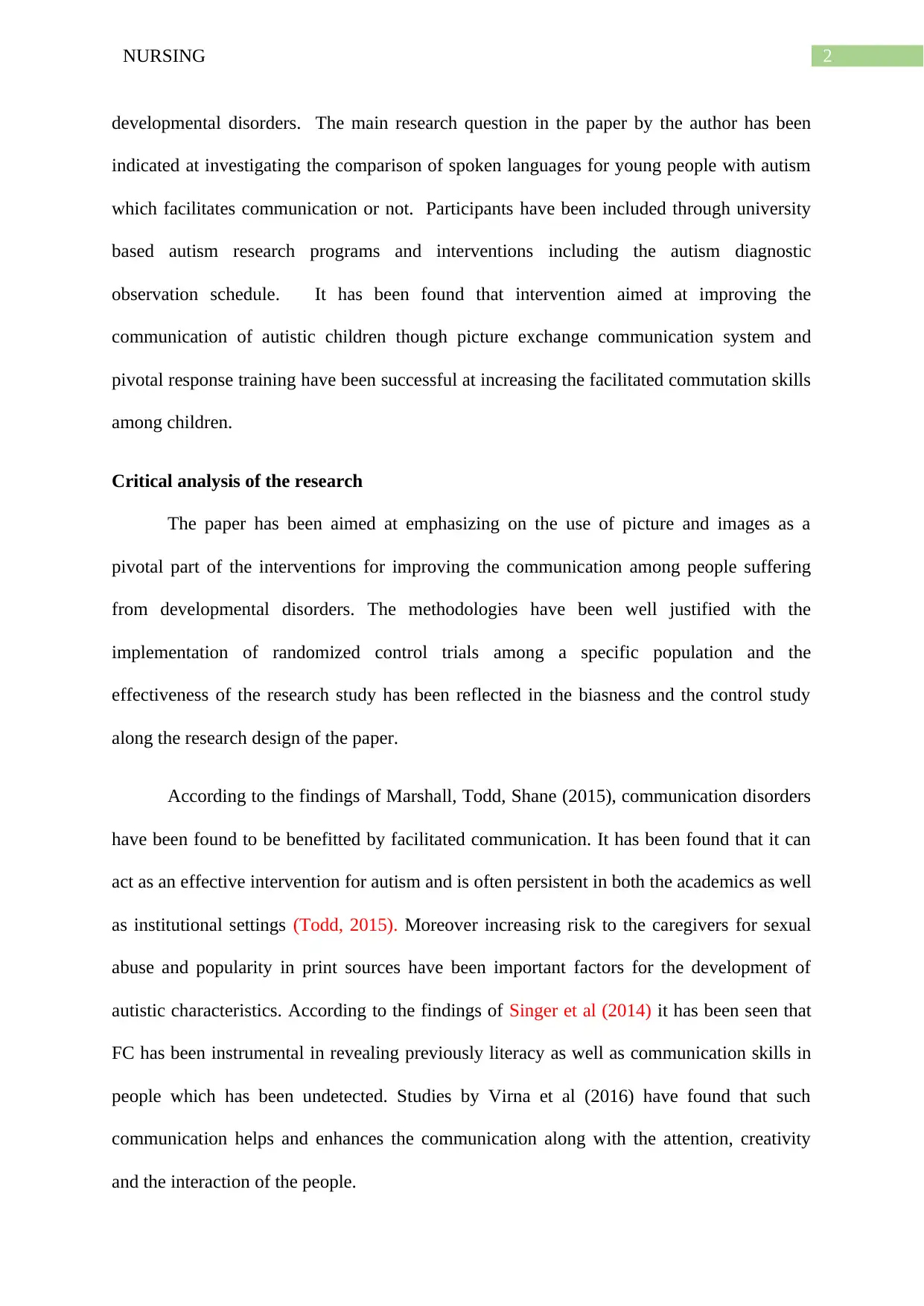
2NURSING
developmental disorders. The main research question in the paper by the author has been
indicated at investigating the comparison of spoken languages for young people with autism
which facilitates communication or not. Participants have been included through university
based autism research programs and interventions including the autism diagnostic
observation schedule. It has been found that intervention aimed at improving the
communication of autistic children though picture exchange communication system and
pivotal response training have been successful at increasing the facilitated commutation skills
among children.
Critical analysis of the research
The paper has been aimed at emphasizing on the use of picture and images as a
pivotal part of the interventions for improving the communication among people suffering
from developmental disorders. The methodologies have been well justified with the
implementation of randomized control trials among a specific population and the
effectiveness of the research study has been reflected in the biasness and the control study
along the research design of the paper.
According to the findings of Marshall, Todd, Shane (2015), communication disorders
have been found to be benefitted by facilitated communication. It has been found that it can
act as an effective intervention for autism and is often persistent in both the academics as well
as institutional settings (Todd, 2015). Moreover increasing risk to the caregivers for sexual
abuse and popularity in print sources have been important factors for the development of
autistic characteristics. According to the findings of Singer et al (2014) it has been seen that
FC has been instrumental in revealing previously literacy as well as communication skills in
people which has been undetected. Studies by Virna et al (2016) have found that such
communication helps and enhances the communication along with the attention, creativity
and the interaction of the people.
developmental disorders. The main research question in the paper by the author has been
indicated at investigating the comparison of spoken languages for young people with autism
which facilitates communication or not. Participants have been included through university
based autism research programs and interventions including the autism diagnostic
observation schedule. It has been found that intervention aimed at improving the
communication of autistic children though picture exchange communication system and
pivotal response training have been successful at increasing the facilitated commutation skills
among children.
Critical analysis of the research
The paper has been aimed at emphasizing on the use of picture and images as a
pivotal part of the interventions for improving the communication among people suffering
from developmental disorders. The methodologies have been well justified with the
implementation of randomized control trials among a specific population and the
effectiveness of the research study has been reflected in the biasness and the control study
along the research design of the paper.
According to the findings of Marshall, Todd, Shane (2015), communication disorders
have been found to be benefitted by facilitated communication. It has been found that it can
act as an effective intervention for autism and is often persistent in both the academics as well
as institutional settings (Todd, 2015). Moreover increasing risk to the caregivers for sexual
abuse and popularity in print sources have been important factors for the development of
autistic characteristics. According to the findings of Singer et al (2014) it has been seen that
FC has been instrumental in revealing previously literacy as well as communication skills in
people which has been undetected. Studies by Virna et al (2016) have found that such
communication helps and enhances the communication along with the attention, creativity
and the interaction of the people.
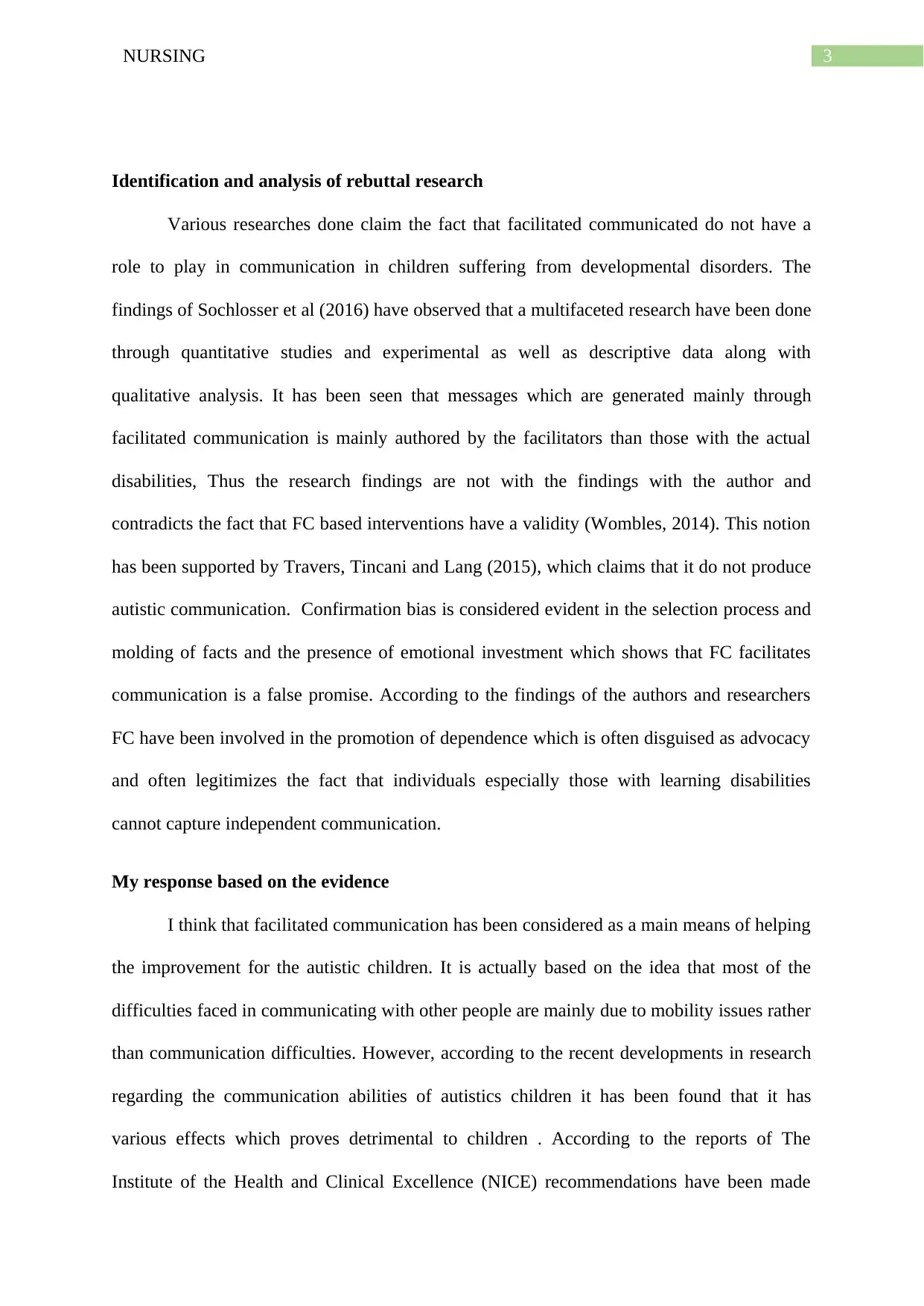
3NURSING
Identification and analysis of rebuttal research
Various researches done claim the fact that facilitated communicated do not have a
role to play in communication in children suffering from developmental disorders. The
findings of Sochlosser et al (2016) have observed that a multifaceted research have been done
through quantitative studies and experimental as well as descriptive data along with
qualitative analysis. It has been seen that messages which are generated mainly through
facilitated communication is mainly authored by the facilitators than those with the actual
disabilities, Thus the research findings are not with the findings with the author and
contradicts the fact that FC based interventions have a validity (Wombles, 2014). This notion
has been supported by Travers, Tincani and Lang (2015), which claims that it do not produce
autistic communication. Confirmation bias is considered evident in the selection process and
molding of facts and the presence of emotional investment which shows that FC facilitates
communication is a false promise. According to the findings of the authors and researchers
FC have been involved in the promotion of dependence which is often disguised as advocacy
and often legitimizes the fact that individuals especially those with learning disabilities
cannot capture independent communication.
My response based on the evidence
I think that facilitated communication has been considered as a main means of helping
the improvement for the autistic children. It is actually based on the idea that most of the
difficulties faced in communicating with other people are mainly due to mobility issues rather
than communication difficulties. However, according to the recent developments in research
regarding the communication abilities of autistics children it has been found that it has
various effects which proves detrimental to children . According to the reports of The
Institute of the Health and Clinical Excellence (NICE) recommendations have been made
Identification and analysis of rebuttal research
Various researches done claim the fact that facilitated communicated do not have a
role to play in communication in children suffering from developmental disorders. The
findings of Sochlosser et al (2016) have observed that a multifaceted research have been done
through quantitative studies and experimental as well as descriptive data along with
qualitative analysis. It has been seen that messages which are generated mainly through
facilitated communication is mainly authored by the facilitators than those with the actual
disabilities, Thus the research findings are not with the findings with the author and
contradicts the fact that FC based interventions have a validity (Wombles, 2014). This notion
has been supported by Travers, Tincani and Lang (2015), which claims that it do not produce
autistic communication. Confirmation bias is considered evident in the selection process and
molding of facts and the presence of emotional investment which shows that FC facilitates
communication is a false promise. According to the findings of the authors and researchers
FC have been involved in the promotion of dependence which is often disguised as advocacy
and often legitimizes the fact that individuals especially those with learning disabilities
cannot capture independent communication.
My response based on the evidence
I think that facilitated communication has been considered as a main means of helping
the improvement for the autistic children. It is actually based on the idea that most of the
difficulties faced in communicating with other people are mainly due to mobility issues rather
than communication difficulties. However, according to the recent developments in research
regarding the communication abilities of autistics children it has been found that it has
various effects which proves detrimental to children . According to the reports of The
Institute of the Health and Clinical Excellence (NICE) recommendations have been made
Secure Best Marks with AI Grader
Need help grading? Try our AI Grader for instant feedback on your assignments.
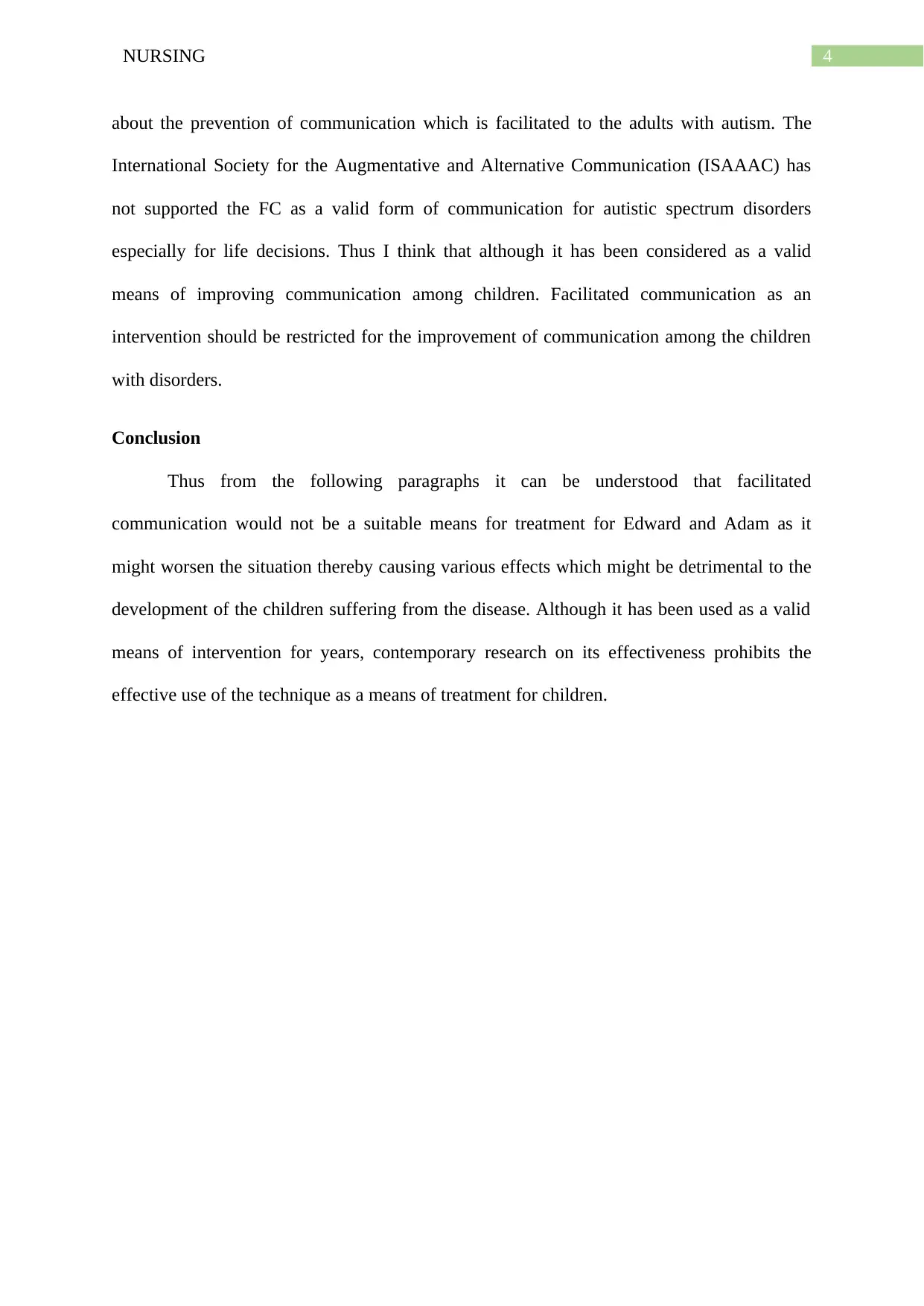
4NURSING
about the prevention of communication which is facilitated to the adults with autism. The
International Society for the Augmentative and Alternative Communication (ISAAAC) has
not supported the FC as a valid form of communication for autistic spectrum disorders
especially for life decisions. Thus I think that although it has been considered as a valid
means of improving communication among children. Facilitated communication as an
intervention should be restricted for the improvement of communication among the children
with disorders.
Conclusion
Thus from the following paragraphs it can be understood that facilitated
communication would not be a suitable means for treatment for Edward and Adam as it
might worsen the situation thereby causing various effects which might be detrimental to the
development of the children suffering from the disease. Although it has been used as a valid
means of intervention for years, contemporary research on its effectiveness prohibits the
effective use of the technique as a means of treatment for children.
about the prevention of communication which is facilitated to the adults with autism. The
International Society for the Augmentative and Alternative Communication (ISAAAC) has
not supported the FC as a valid form of communication for autistic spectrum disorders
especially for life decisions. Thus I think that although it has been considered as a valid
means of improving communication among children. Facilitated communication as an
intervention should be restricted for the improvement of communication among the children
with disorders.
Conclusion
Thus from the following paragraphs it can be understood that facilitated
communication would not be a suitable means for treatment for Edward and Adam as it
might worsen the situation thereby causing various effects which might be detrimental to the
development of the children suffering from the disease. Although it has been used as a valid
means of intervention for years, contemporary research on its effectiveness prohibits the
effective use of the technique as a means of treatment for children.
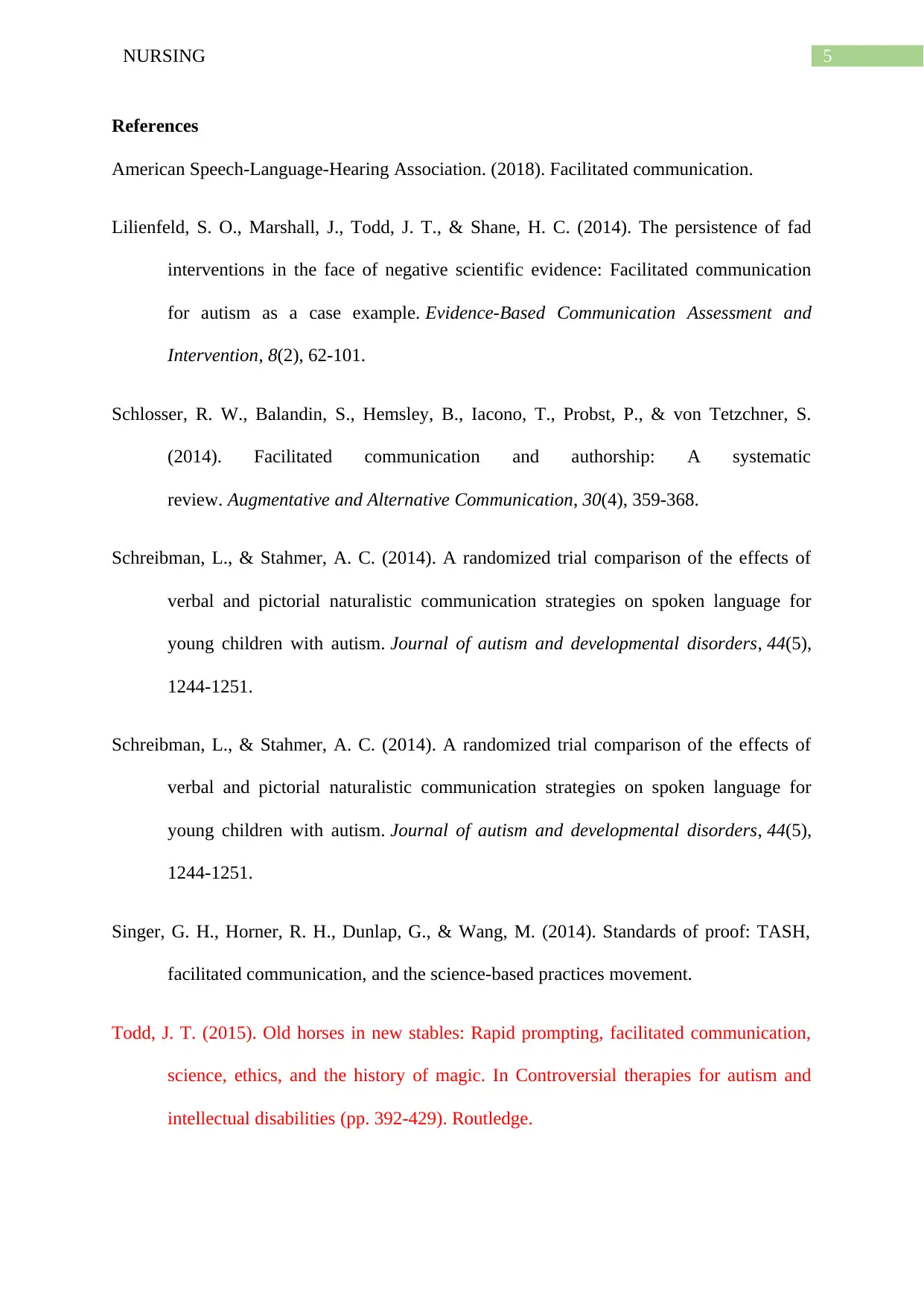
5NURSING
References
American Speech-Language-Hearing Association. (2018). Facilitated communication.
Lilienfeld, S. O., Marshall, J., Todd, J. T., & Shane, H. C. (2014). The persistence of fad
interventions in the face of negative scientific evidence: Facilitated communication
for autism as a case example. Evidence-Based Communication Assessment and
Intervention, 8(2), 62-101.
Schlosser, R. W., Balandin, S., Hemsley, B., Iacono, T., Probst, P., & von Tetzchner, S.
(2014). Facilitated communication and authorship: A systematic
review. Augmentative and Alternative Communication, 30(4), 359-368.
Schreibman, L., & Stahmer, A. C. (2014). A randomized trial comparison of the effects of
verbal and pictorial naturalistic communication strategies on spoken language for
young children with autism. Journal of autism and developmental disorders, 44(5),
1244-1251.
Schreibman, L., & Stahmer, A. C. (2014). A randomized trial comparison of the effects of
verbal and pictorial naturalistic communication strategies on spoken language for
young children with autism. Journal of autism and developmental disorders, 44(5),
1244-1251.
Singer, G. H., Horner, R. H., Dunlap, G., & Wang, M. (2014). Standards of proof: TASH,
facilitated communication, and the science-based practices movement.
Todd, J. T. (2015). Old horses in new stables: Rapid prompting, facilitated communication,
science, ethics, and the history of magic. In Controversial therapies for autism and
intellectual disabilities (pp. 392-429). Routledge.
References
American Speech-Language-Hearing Association. (2018). Facilitated communication.
Lilienfeld, S. O., Marshall, J., Todd, J. T., & Shane, H. C. (2014). The persistence of fad
interventions in the face of negative scientific evidence: Facilitated communication
for autism as a case example. Evidence-Based Communication Assessment and
Intervention, 8(2), 62-101.
Schlosser, R. W., Balandin, S., Hemsley, B., Iacono, T., Probst, P., & von Tetzchner, S.
(2014). Facilitated communication and authorship: A systematic
review. Augmentative and Alternative Communication, 30(4), 359-368.
Schreibman, L., & Stahmer, A. C. (2014). A randomized trial comparison of the effects of
verbal and pictorial naturalistic communication strategies on spoken language for
young children with autism. Journal of autism and developmental disorders, 44(5),
1244-1251.
Schreibman, L., & Stahmer, A. C. (2014). A randomized trial comparison of the effects of
verbal and pictorial naturalistic communication strategies on spoken language for
young children with autism. Journal of autism and developmental disorders, 44(5),
1244-1251.
Singer, G. H., Horner, R. H., Dunlap, G., & Wang, M. (2014). Standards of proof: TASH,
facilitated communication, and the science-based practices movement.
Todd, J. T. (2015). Old horses in new stables: Rapid prompting, facilitated communication,
science, ethics, and the history of magic. In Controversial therapies for autism and
intellectual disabilities (pp. 392-429). Routledge.
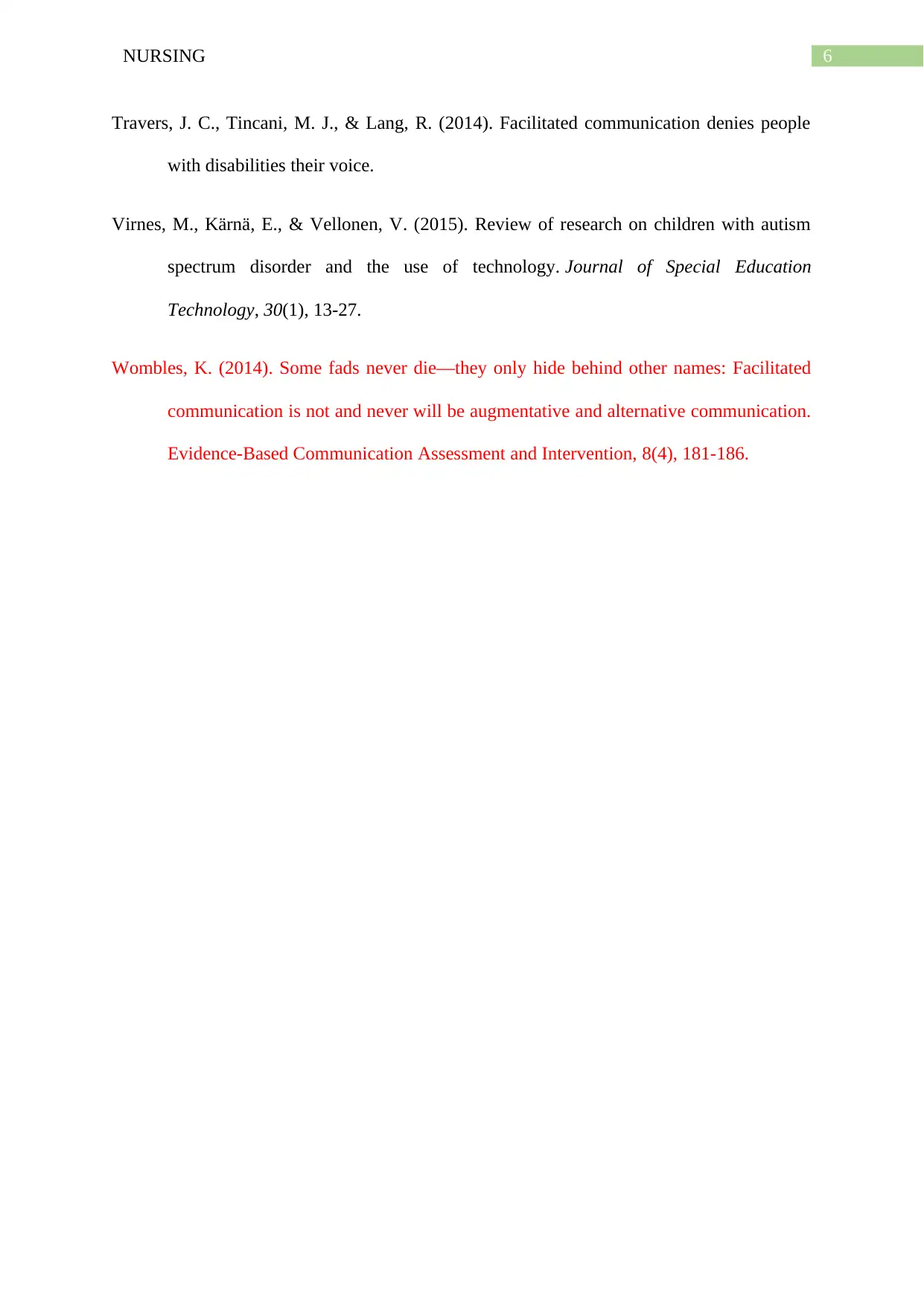
6NURSING
Travers, J. C., Tincani, M. J., & Lang, R. (2014). Facilitated communication denies people
with disabilities their voice.
Virnes, M., Kärnä, E., & Vellonen, V. (2015). Review of research on children with autism
spectrum disorder and the use of technology. Journal of Special Education
Technology, 30(1), 13-27.
Wombles, K. (2014). Some fads never die—they only hide behind other names: Facilitated
communication is not and never will be augmentative and alternative communication.
Evidence-Based Communication Assessment and Intervention, 8(4), 181-186.
Travers, J. C., Tincani, M. J., & Lang, R. (2014). Facilitated communication denies people
with disabilities their voice.
Virnes, M., Kärnä, E., & Vellonen, V. (2015). Review of research on children with autism
spectrum disorder and the use of technology. Journal of Special Education
Technology, 30(1), 13-27.
Wombles, K. (2014). Some fads never die—they only hide behind other names: Facilitated
communication is not and never will be augmentative and alternative communication.
Evidence-Based Communication Assessment and Intervention, 8(4), 181-186.
1 out of 7
Related Documents
Your All-in-One AI-Powered Toolkit for Academic Success.
+13062052269
info@desklib.com
Available 24*7 on WhatsApp / Email
![[object Object]](/_next/static/media/star-bottom.7253800d.svg)
Unlock your academic potential
© 2024 | Zucol Services PVT LTD | All rights reserved.





